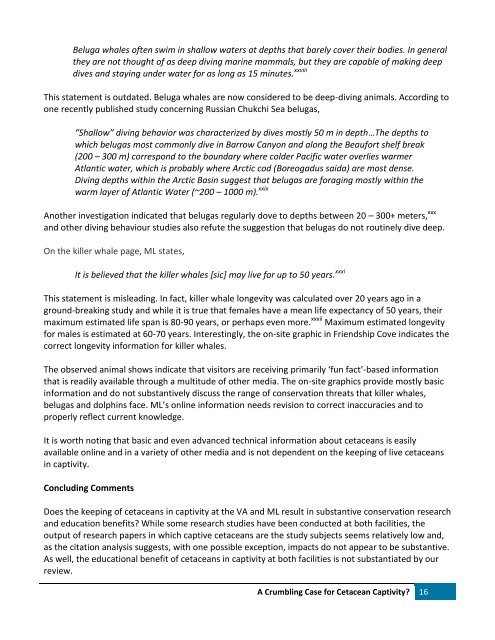A CRUMBLING CASE FOR CETACEAN CAPTIVITY?
MM-Education-and-Conservation-Report-Dec-9-2016-fi
MM-Education-and-Conservation-Report-Dec-9-2016-fi
You also want an ePaper? Increase the reach of your titles
YUMPU automatically turns print PDFs into web optimized ePapers that Google loves.
Beluga whales often swim in shallow waters at depths that barely cover their bodies. In general<br />
they are not thought of as deep diving marine mammals, but they are capable of making deep<br />
dives and staying under water for as long as 15 minutes. xxviii<br />
This statement is outdated. Beluga whales are now considered to be deep-diving animals. According to<br />
one recently published study concerning Russian Chukchi Sea belugas,<br />
“Shallow” diving behavior was characterized by dives mostly 50 m in depth…The depths to<br />
which belugas most commonly dive in Barrow Canyon and along the Beaufort shelf break<br />
(200 – 300 m) correspond to the boundary where colder Pacific water overlies warmer<br />
Atlantic water, which is probably where Arctic cod (Boreogadus saida) are most dense.<br />
Diving depths within the Arctic Basin suggest that belugas are foraging mostly within the<br />
warm layer of Atlantic Water (~200 – 1000 m). xxix<br />
Another investigation indicated that belugas regularly dove to depths between 20 – 300+ meters, xxx<br />
and other diving behaviour studies also refute the suggestion that belugas do not routinely dive deep.<br />
On the killer whale page, ML states,<br />
It is believed that the killer whales [sic] may live for up to 50 years. xxxi<br />
This statement is misleading. In fact, killer whale longevity was calculated over 20 years ago in a<br />
ground-breaking study and while it is true that females have a mean life expectancy of 50 years, their<br />
maximum estimated life span is 80-90 years, or perhaps even more. xxxii Maximum estimated longevity<br />
for males is estimated at 60-70 years. Interestingly, the on-site graphic in Friendship Cove indicates the<br />
correct longevity information for killer whales.<br />
The observed animal shows indicate that visitors are receiving primarily ‘fun fact’-based information<br />
that is readily available through a multitude of other media. The on-site graphics provide mostly basic<br />
information and do not substantively discuss the range of conservation threats that killer whales,<br />
belugas and dolphins face. ML’s online information needs revision to correct inaccuracies and to<br />
properly reflect current knowledge.<br />
It is worth noting that basic and even advanced technical information about cetaceans is easily<br />
available online and in a variety of other media and is not dependent on the keeping of live cetaceans<br />
in captivity.<br />
Concluding Comments<br />
Does the keeping of cetaceans in captivity at the VA and ML result in substantive conservation research<br />
and education benefits? While some research studies have been conducted at both facilities, the<br />
output of research papers in which captive cetaceans are the study subjects seems relatively low and,<br />
as the citation analysis suggests, with one possible exception, impacts do not appear to be substantive.<br />
As well, the educational benefit of cetaceans in captivity at both facilities is not substantiated by our<br />
review.<br />
A Crumbling Case for Cetacean Captivity? 16


